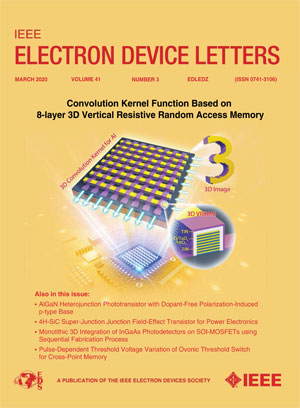15.1 W/mm Power Density GaN-on-GaN HEMT With High-Gradient Stepped-C Doped Buffer
IF 4.1
2区 工程技术
Q2 ENGINEERING, ELECTRICAL & ELECTRONIC
引用次数: 0
Abstract
In this work, we propose for the first time a high-gradient (HG) stepped-Carbon (stepped-C) doped buffer design in GaN-on-GaN structures to enhance device RF performance. This design not only avoids the impact of the Fe tailing effect on the 2DEG but also effectively mitigates interface conduction losses caused by Si impurities at the regrown interface. Most importantly, the HG stepped-C buffer design significantly alleviates the trapping effects associated with high concentrations of C. The GaN-on-GaN HEMTs with HG stepped-C buffer achieved a breakdown voltage of 249 V, a peak transconductance (15.1 W/mm功率密度GaN-on-GaN HEMT与高梯度阶跃c掺杂缓冲
在这项工作中,我们首次在GaN-on-GaN结构中提出了一种高梯度(HG)阶跃碳(stepping - c)掺杂缓冲设计,以提高器件的射频性能。该设计既避免了Fe尾矿效应对2DEG的影响,又有效减轻了Si杂质在再生界面处造成的界面传导损失。最重要的是,HG阶跃c缓冲器设计显著减轻了与高浓度c相关的捕获效应,具有HG阶跃c缓冲器的GaN-on-GaN HEMTs的击穿电压为249 V,峰值跨导(${g}_{\text {m}}\text{)}$为319 mS/mm,低电流崩溃(CC)为6.1%。总的来说,这些因素使GaN-on-GaN hemt实现了47.6 GHz/68.1GHz的${f}_{\text {T}}$ / ${f}_{\max}$值,最先进的输出功率密度(${P}_{\text {out}}}\text{)}$为15.1 W/mm, 2ghz时的功率附加效率(PAE)为57.2%。这些结果证明了HG阶进c缓冲器在提高GaN-on-GaN hemt射频性能方面的巨大潜力。
本文章由计算机程序翻译,如有差异,请以英文原文为准。
求助全文
约1分钟内获得全文
求助全文
来源期刊

IEEE Electron Device Letters
工程技术-工程:电子与电气
CiteScore
8.20
自引率
10.20%
发文量
551
审稿时长
1.4 months
期刊介绍:
IEEE Electron Device Letters publishes original and significant contributions relating to the theory, modeling, design, performance and reliability of electron and ion integrated circuit devices and interconnects, involving insulators, metals, organic materials, micro-plasmas, semiconductors, quantum-effect structures, vacuum devices, and emerging materials with applications in bioelectronics, biomedical electronics, computation, communications, displays, microelectromechanics, imaging, micro-actuators, nanoelectronics, optoelectronics, photovoltaics, power ICs and micro-sensors.
 求助内容:
求助内容: 应助结果提醒方式:
应助结果提醒方式:


